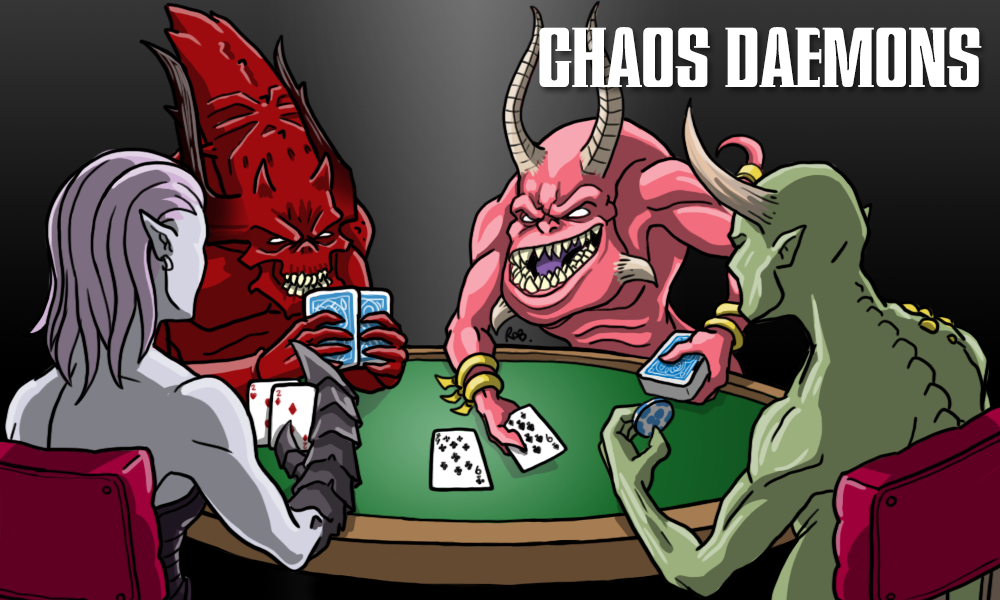9th edition is here, and with it a whole raft of changes to the factions of Warhammer 40,000. With the Munitorum Field Manual out in the wild and the Faction FAQs released, now’s a good time to start taking a look at what’s changed for all of our favorite armies. Today, Robert “TheChirurgeon” Jones is talking about Chaos Daemons.
OK, I’ve spent enough time covering the mortal slaves to darkness of the 40k universe. Now it’s time to cover Chaos Daemons. In what was a cruel twist of fate, the Chaos Daemons faction saw an exciting release in Engine War pass by with almost no play time before the launch of 9th edition completely changed the landscape again. So as we sit down to evaluate the faction in 9th edition, we’ve got more question marks than with most factions, since we’re evaluating and speculating on their Engine War upgrades as much as their general performance in 9th. Still, there’s a lot here to say about how the game has changed and with it, how Daemons play. So let’s dive in.
The Rules Impact
First off, a number of rules changed and a lot of these directly impact Chaos Daemons.
Changes to Melee Combat
Melee combat has changed a bit in 9th; the ability to trap units has been significantly reduced, charges have become slightly more difficult thanks to the CP re-roll change, multi-charging has become much more difficult, units that Heroically Intervene can be attacked by chargers, and vehicles are able to shoot in combat, preventing them from being “turned off” by melee units that reach them. These are, for the most part, negative changes for Chaos Daemons. Charging Vehicles no longer saves you from being shot by them, trapping units is much harder, and charging multiple units will be a big challenge. The upside is that abilities that prevent enemies from making a Fall Back move will prevent Desperate Breakouts (how these interact likely needs an FAQ but as written it appears they can’t attempt a Fall Back move and so won’t be wiped out), but on the whole, these are tough changes for an army that relies heavily on melee combat.
Changes to Unit Coherency
Another major change that affects Chaos Daemons more than other factions, unit coherency now requires each model in a unit be within 2″ of two other models in the unit if the unit has more than 6 models; additionally, coherency is checked at the end of each Morale phase, and any models out of unit coherency are removed as casualties. This is a big deal for Chaos Daemons, who often rely on units with 20+ models and made a habit of running long strings of models in 8th in order to hold multiple objectives simultaneously. With the new coherency rules these long chains of models aren’t as useful and if you’re not careful about how you remove casualties and pick targets you can find yourself losing a significant number of models to coherency checks. On the subject of large units…
Blast Weapons
Blast weapons represent a huge problem for horde strategies in 9th edition, giving said weapons a minimum of 3 shots against units of 6-10 models and maximum shots against units of 11+ models. This is a real issue for large units of Daemon Troops, where having 20+ models is where you start to get good bonuses. The net impact is that you’ll need a way to protect daemons more from being shot and you’ll likely want to take a harder look at Daemons units that don’t come in massive blobs.
Vehicles, Monsters, and Shooting
The new Big Guns Never Tire rule allows vehicles and monsters to move and shoot heavy weapons with no penalty to hit and shoot non-Blast weapons in combat at the units that they’re engaged with. This improves some units considerably… but almost all of them are in other factions. The big impact of this is that vehicles will happily shoot at you while locked in combat, so you’ll need to try and make charging vehicles a more deadly affair than a means to prevent them from shooting.
Missions
The GT mission pack changes things significantly for 9th edition, changing how missions are scored and what player priorities will be on a turn-by-turn basis. Perhaps the biggest change is top-of-turn scoring for primary objectives, i.e. players score for holding objectives in their Command phases, which means that a unit has to already be on your objective holding it before your turn starts to score. Going first this means you need units that can move quickly to capture objectives and then stay alive while holding them. Going second this means you need to be highly conscious that only have four scoring turns and you need units that can whip an enemy unit off an objective while simultaneously moving onto that objective to occupy it. Chaos Daemons have some great options for ensuring they’re holding objectives early, and lots of troops that can push onto them in the charge and fight phases.
Strategic Reserves
While Chaos Daemons have the ability to put units into the warp to teleport onto the battlefield with the Denizens of the Warp Stratagem, this ability is a bit limited since it costs you 1 CP for a single unit of PL 8 or less, or 2 CP for a unit of PL 9+. Comparatively, Strategic Reserves gives you less freedom with regard to your placement but will give you more units, costing you 1 CP for up to 9 PL worth of units held in Reserves, 2 CP for up to 19, 3 CP for up to 29, and so on. This may give you a more economic way to to hold units, since you can likely fit 3 units into 19 PL depending on what units you pick. It’s also possible that post-PL update there may be a few 9 PL units that this makes economic sense to use over Denizens of the Warp.
Picking All of Your Upgrades Pre-Game
This is a bigger deal for competitive play than casual, but previously many rules such as Psychic powers, add-on Warlord Traits and Relics, and using stratagems that Exalt your Greater Daemons were done at the start of the game, after you’d seen your opponent’s list, allowing you a chance to respond to what they were bringing. That’s not the case anymore, meaning that we have to be much more laser-focused with our pre-game strategy, and it means that a lot of traits and powers that we’d have used conditionally now just aren’t likely to make it into our lists. Note that if you’re rolling for random Exalted traits for your Greater Daemons, those rolls happen before you make decisions about placing units in Reserves.
Army Construction
Army construction has changed significantly in 9th edition, making soup lists much more costly and difficult to create. For Chaos Daemons this means that monofaction lists will probably have more CP to work with than they did in 8th, but soup lists will feel the costs, and lists are more likely to use two detachments (a Battalion + a Patrol) rather than three. Additionally, HQs have become a real problem, since most lists will want more HQs than a standard Battatlion detachment allows.
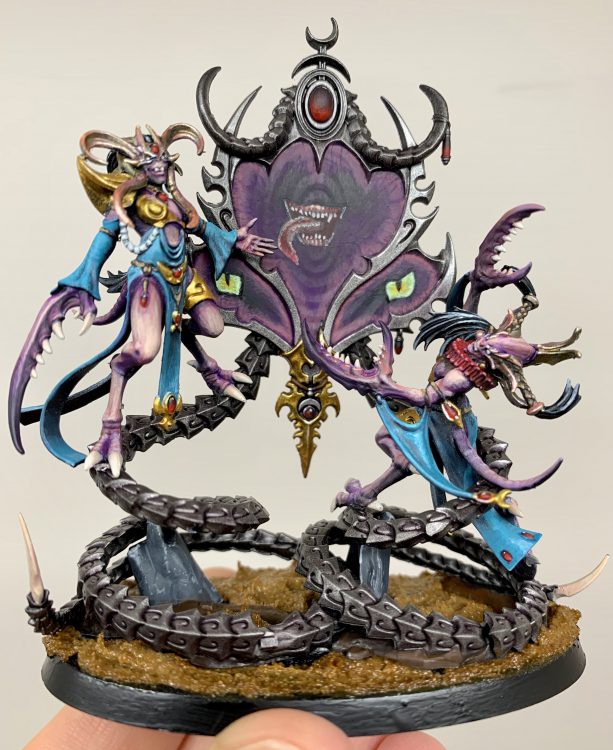
The FAQs
In addition to the core rules of 9th changing things up from 8th, we’ve also received a set of new FAQs addressing issues in the Codex and Engine War. The most notable changes in these FAQs are for Engine War:
- The Keeper of Secrets’ datasheet got updated again, returning the unit to its rightful 14″ Movement.
- You can only exalt each greater daemon once.
- The rules for several whips like Effluvior and the Scourging Whip changed to no longer explicitly allow the wielder to attack in combat and out of combat; they are now subject to the MONSTER rules in 9th edition. This was a bit of a nerf, as it means that the Effluvior can’t attack units outside the bearer’s Engagement Range if the bearer is locked in combat.
- The Feculent Gnarlmaw now confers the benefits of Light Cover, plus an extra +1 to the armor save.
The Points Changes
The Munitorum Field Guide shifted the points for almost every unit in the Chaos Daemons army (and most of the units in the game), rounding most points values up. In determining the “winners and losers” as it relates to points increases, it’s important that we think in relative terms – that is, every unit increased in price, so that a unit went up isn’t as important as whether it went up by more or less than the average. Also note that even an above-average increase may not make a unit bad; units that were significantly undercosted pre-9th edition may merely be “good” after a points hike.

HQ
Greater Daemons went up 20 points almost across the board (the Bloodthirster of Insensate Rage, the one with the big axe, went up 30), pretty much in-line with other units based on their cost. The Keeper of Secrets and Lord of Change came out of this the best, since they were useful before and haven’t gone up by enough to make them bad. Exalted Lords of Change and Keepers of Secrets can also take some great abilities from Engine War and have enough good ones that it might be worth rolling for them at random to get two
The Bloodthirster and Great Unclean one are still overpriced and the Great Unclean one suffers from the new terrain rules, which make it visible through obscuring terrain. The rest of the HQs made out OK with 5- and 10-point adjustments with the exception of the Winged Daemon Prince of Chaos (+30), who is the big loser here as a result of the inexplicable need to make every Daemon Prince cost the same amount of points despite having different statlines, rules, and powers. The Winged Daemon Prince was already a rare sight in Chaos Daemons and so that’s not likely to change now.
Does this mean Greater Daemons are back? Kind of – they have some other issues to sort out, which we’ll talk about in the Secondary Objectives section. Otherwise, the HQs that were good before are still mostly good now.
Troops
Troop-wise, Chaos Daemons did alright. Bloodletters went up to 8 points, which pleases Khorne. Pink Horrors went up 1 point to 8, while blue horrors and brimstones took larger hits, going up 2 apiece. Long chains of Brimstone Horrors were already dead thanks to the new coherency rules, so the big impact here is the number of reinforcement points you’ll need to set aside for splitting, which we’ll talk about later. Plaguebearers also catch a hit here, going up another point and while for 9th that’s not too bad, it’s not great given that they’d already gone up a point back in Chapter Approved 2019. It’s also notable that you can’t usefully stack them to -2 to hit any more. Still, they’re not completely out of consideration given their resilience, but this is another are where the new coherency rules don’t work in their favor.
The big winners here are Daemonettes, who went up only one point and at 7ppm are a good deal, and Nurglings, who appear to be unchanged at 18 points per model. I say “appear” because they are listed at 20 points per model under the Death Guard section of the Munitorum Field Manual and while it seems insane to suggest that might be the real cost, there’s a chance GW could change either entry in an upcoming FAQ. So be aware that you may need 6-20 points to free up for Nurglings. Even at 20 points however, Nurglings are a steal in this edition with their ability to be on top of objectives before the game starts and how annoying they can be to kill, drawing big firepower away from other units and being weirdly more resilient to Blast weapons than other options.

Elites
Some minor-but-probably-a-bit-too-high adjustments here, with Beasts of Nurgle and Bloodcrushers going up 5 points each. The Beasts make out better on this end, since their resilience (T5, 5 wounds and Disgustingly Resilient) makes them good for holding objectives and their ability to Heroically Intervene means that they can move on or toward them off-turn, making them a better fit for 9th edition play. Fiends got off with only a 3-point increase, making them another decent choice given how their Soporific Musk ability has become even stronger – enemy units within 1″ can’t use the Desperate Breakout Stratagem to Fall Back and not working on FLY units is less of a big deal now they don’t get a free Fall Back and shoot. Just watch out for vehicles, who can now gladly still light you up while engaged. Exalted Flamers get the worst of this, with a 10-point increase and little to show for it. They’re still some of the faction’s best shooting, though.
Fast Attack
The Fast Attack slot for Daemons saw only minor increases for most models, with the most severe probably being for Flesh Hounds and Seekers, which jumped 3 ppm each (to 18). The big potential winners here are Furies (+2 ppm) and Screamers (+3 ppm), the latter of which may be a bit more useful with the addition of the Warp Jaws Stratagem to help shore them up against heavier targets. 18-point Seekers seem a bit more palatable than 18-point Flesh Hounds, especially given how 9th edition is going to push toward fewer armies with 1-2 Psykers.
Heavy Support
The much-maligned Heavy Support slot for Chaos Daemons saw a collection of 10-point increases for every unit. This isn’t that big an increase, but most of the Daemons Heavy Support choices are hampered by being Chariots and not Vehicles or Monsters, meaning they get nothing out of the new rules. The exception is the biggest winner of these rules and points changes: The Soul Grinder, which in going from 180 to 190 points sees only a small percentage increase, and as a Vehicle gains the benefits of Big Guns Never Tire.
Fortifications
The Feculent Gnarlmaw is the only option really worth discussing here; those went up 10 points and per the Daemons FAQ now give Light cover, plus an extra +1 to save rolls.
Overall Chaos Daemons did pretty well in the points adjustment! I was probably a bit too harsh on them in our original assessment of factions immediately following our review of the Munitorum Field Manual points update. The real question is how they play.
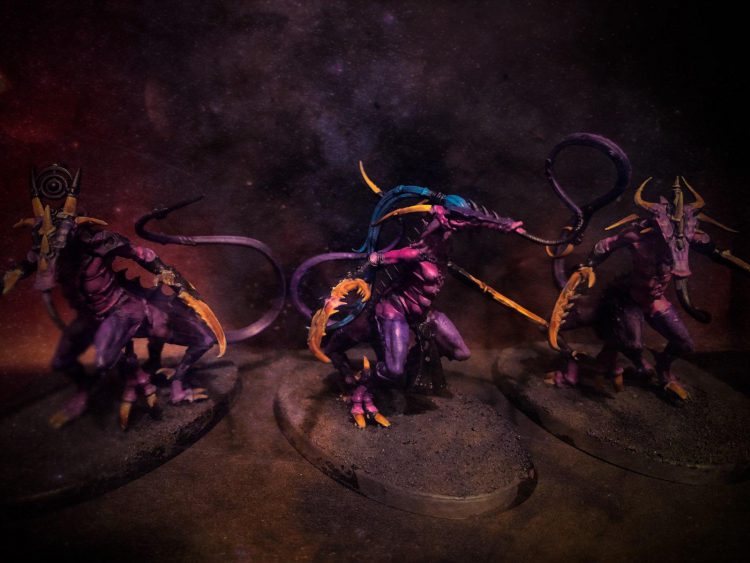
How They Play
The Chaos Daemons faction hasn’t changed all that much from our review of Engine War, which significantly improved Greater Daemons and a number of units. The most notable changes however are the changes to the army construction and the changes to missions that have shifted a number of priorities, making the game even at a casual level about accomplishing Primary and Secondary Objectives. So let’s dig into each of those individually and see what we can divine about the army.
Army Construction
Army construction is a big challenge for Chaos Daemons in 9th edition. While on the face of things, a monofaction Daemons Army now has more CP to play with if it doesn’t invest in a second Battalion, the downside is the Daemons army isn’t built for a Brigade, with neither the Fast Attack nor the Heavy Support slots being strong enough that you’d want to have three of each. However, a single Battalion only gives you three HQ slots to work with, which will seldom be enough for what you want. Going Battalion + Patrol is OK, but 5 HQ slots may still not always be sufficient and so double Battalion Daemons armies may be more common.
The other way around this is Summoning. By choosing to summon certain HQs, you can circumvent the restrictions and save some CP, though this requires building a plan around how and when to summon, and works best for cheaper HQs like the heralds. It’s potentially better than it was, and summoning can also be a way to move slower Nurgle units like Beasts onto objectives, though on the whole Summoning is probably a better strategy for Chaos Space Marine factions adding daemons than for a daemons army looking to bring in more HQs.
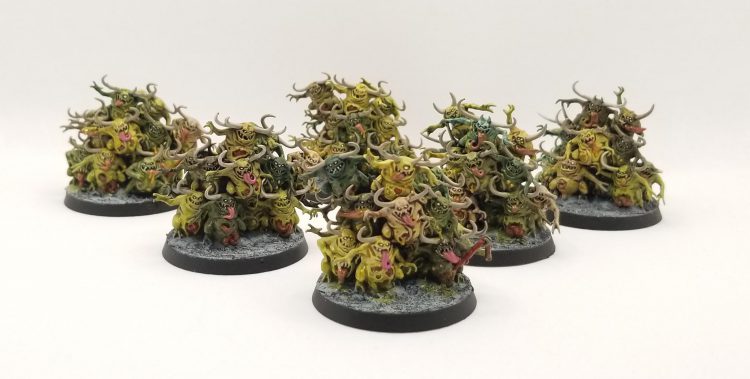
Primary Objectives
A major point of emphasis in 9th edition is on scoring Primary Objectives, ideally through the ability to string together 10- and 15-point turns. A 10-point turn will usually mean holding two and sometimes three objectives at the start of your turn, and a 15-point turn will mean holding more than the opponent. Because you need to be on an objective at the start of your turn, this means that 9th edition rewards taking units that can quickly move onto and capture objectives and are durable enough hold them for an entire turn, such as Nurglings (who can deploy onto objectives), and units that can clear and capture an occupied objective in the same turn (melee units) or, even better, move and capture objectives outside your turn (units that can Heroically Intervene such as Characters and Beasts of Nurgle).
Even if their cost is increased to 20 points per model, Nurglings have suddenly become one of the game’s best units. They’re an efficiently-costed Troops choice that can eat a significant amount of D1 firepower, they can replenish their numbers with Nurgling Infestation, and they can start the game on objectives thanks to the Mischief Makers rule. Without any secondary that punishes you, Nurglings have become an amazing go-to Troops choice and something that has a strong case for showing up in every Daemons army. Despite their points increase, Pink Horrors also have a case to be made if you’re packing sufficient psykers. While not able to deploy forward like Nurglings, Pink Horrors can take advantage of the new morale rules: Splitting into Blue Horrors increases the unit size without increasing the unit’s starting size, ensuring you won’t have to worry about going below half strength for the purposes of Combat Attrition Tests (you’ll only lose models on a roll of 1 instead of a 1 or 2 unless even with blues you’re below half of your starting strength), should you fail a morale test. This can make a 30-model blob of Horrors with reinforcement points set aside for blue Horrors very tough to chew through as well. Plaguebearers can also still be an absolute slog to remove as well, and their costs haven’t increased so much that they’re un-fieldable. Their biggest disadvantage here is their slow speed.
On the other hand, Beasts of Nurgle benefit from the loss of Gangbusters while their ability to Heroically Intervene with Attention Seekers makes them incredibly dangerous and resilient threats who can move off-turn if an opponent doesn’t charge them, ruining enemy plans and flipping objectives off-turn. What’s more, if you intervene against a unit that didn’t charge this turn, you can fight before they do, significantly weakening them before the counterattack. This makes Beasts of Nurgle powerful sleeper options in 9th edition, especially at their current cost.
Fiends can also be assets here – they’re able to combine lots of mobility with the ability to trap units in melee combat, protecting themselves through an opponent’s turn. They make a great one-two punch with Daemonettes, where the Daemonettes can use Objective Secured to capture an objective while the Fiends’ Soporific Musk protects the entire unit by trapping its targets in combat, and you have less to fear from multi-unit combats thanks to Quicksilver Swiftness.
The other thing to consider is that the emphasis on holding objectives in forward positions and controlling the middle of the board makes sitting back and shooting with gunlines much less feasible, especially with only five turns to max primaries and top-of-turn scoring. This forces armies into a position to be charged by daemons, and benefits the daemon game plan.
Secondary Objectives
The other half of the game are Secondary Objectives, which make up another 45 points you can score in Matched Play and GT missions. Generally speaking, you want to pick secondary objectives that align with your existing game plan (so secondaries like Domination are good because you already want to capture objectives), and build an army that can accomplish/score 10+ points in two secondaries for sure every game and then plan to pick a third based on your opponent. Objective-based secondaries are likely going to be better and easier to accomplish than kill-based secondaries for Chaos Daemons, in part because of a lack of quality ranged attacks. Daemons should focus on secondaries that emphasize board control and play to their strengths and focus on objectives that are difficult for an opponent to interfere with, either because they’re scored at the end of your turn or don’t rely on an opponent putting a unit in harm’s way.
Battlefield Supremacy secondaries are going to be your bread and butter. Engage on All Fronts is very doable with faster daemons like Fiends, Seekers, or Screamers, and the ability to teleport daemons in or walk them on from another table edge with Strategic Reserves means you can place units further downfield and easily score for them at the end of your turn. Domination also works well here, since it rewards your ability to clear and occupy an objective in the same turn with melee units. Linebreaker on the other hand is a risky pick that requires keeping units in your opponent’s deployment zone for 4 turns to max out and just isn’t that likely.
No Mercy, No Respite secondaries are probably going to make more sense with a Nurgle-heavy army where Grind Them Down can benefit large plaguebearer squads that are hard to remove, or large units of Horrors that can split models and be a chore to grind through, making it likely you can score points for Grind Them Down on a smaller number of kills. Your game plan already relies on killing more units than your opponent most games, anyways. Thin Their Ranks isn’t liable to be something you’ll look at and is really more something you want to make sure you’re not giving up inadvertently – taking 90 pink horrors with splitting is going to make this one a no-brainer against you. While We Stand, We Fight isn’t likely to be a good play, since it’s most often going to double-reward an opponent for killing your greater daemons.
Purge the Enemy secondaries are going to depend on the opponent, where Titan Hunter is a no-brainer against Knights and Bring It Down will be something you bring against vehicle- and monster-heavy armies (and may be something opponents bring against you). Assassinate is also an OK pick if your opponent has 5+ characters and likely something that will get picked against you if you have a psyker-heavy army. Cut Off the Head is a trap. Don’t take it.
Shadow Operations present a series of actions that you can perform to score points. Because you have lots of cheap units that can’t shoot, actions aren’t a terrible deal for Chaos Daemons, except that Nurglings aren’t INFANTRY. Raise the Banners High is the best of these since it “goes off” at the end of your turn and doesn’t require living through a turn of shooting, but you’ll need to make sure you have three objectives tagged with it all game to max it out. Investigate Sites may be OK for faster units but the big challenge is that your opponent can stop that by moving to the middle as well. Deploy Scramblers and Teleport Homer are both a lot riskier and less likely to be worth your consideration.
Finally there’s Warpcraft, which focuses on Pyskers. Although Daemons have cheap Psykers and the ability to take more thanks to Horrors, Psychic Actions can only be done by CHARACTERS, and because those are all in the HQ slot and powerful units, you’ll want them casting psychic powers and smiting rather than spending their psychic phases on actions. The big downside here is Abhor the Witch, which is going to be used against you in almost every game you come up against an army with no psykers, and will typically be combined with Assassinate/Bring It Down to make each Greater Daemon kill worth an insane 8 Victory Points, and that’s for killing a unit that can’t be protected by Look Out, Sir and was already part of your opponent’s game plan. It’s not quite reason enough to not take Greater Daemons, but it makes taking exactly three of them kind of awkward, meaning you may want to conisder going all in and bringing more (or other big things).
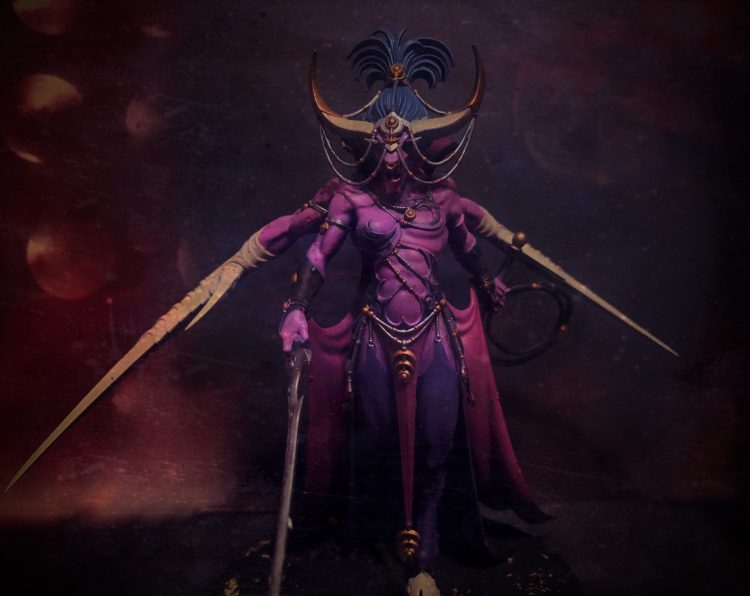
Other Considerations
We can’t go deep on every option, but these are a few more things you might want to think about when building armies.:
- Furies are a potential under-the-radar pick, helping fill out the fast attack slot for cheap. They’re solid both as Nurgle daemons, where Disgustingly Resilient gives them some staying power, and fine as Khorne daemons, where their 2 Attacks and 4 base Strength give them a nasty little punch. They’re also OK as Tzeetnch daemons, though against 1-damage attacks, Disgustingly Resilient gives you better long-term survival odds.
- Soul Grinders are probably worth a second look now. They’re nasty close combat monsters who saw only a small points adjustment in 9th edition, and their ability to shoot in combat as Vehicles and ignore penalties for moving and shooting makes them much more deadly. They can be pretty tough with Disgustingly Resilient (though Ephemeral Form is also more decent here since they’ll face lots of multi-damage attacks), and their shooting gives a Daemon army some real long-distance punch. They’re likely too expensive to run three with three greater daemons in a 2,000-point game, but it’s worth considering them as support now.
- Screamers are worth looking into as well. Their points increase was minor, and they combine fast movement with a 4+ invulnerable save and the ability to hurt Infantry and Vehicles now thanks to Lamprey Bite.
- Flamers are also worth consideration, given that they have the Infantry keyword and are relatively cheap given they have 2 wounds and 12″, AP-1 autohit weapons. Taken in large units they can be pretty nasty when paired with the Flames of Mutation Stratagem from Engine War and they’re decent for performing actions like Raise the Banners High.
- Slaanesh armies have some really interesting options now. The Contorted Epitome is still great, and Daemonettes are big winners in the points department, and got a major upgrade in Engine War from Razor-Sharp Caress. Seekers also got a boost and are worth a look and when combined with Fiends, there’s some really good options here if you can build a game plan around trapping enemy units in combat as a way to protect yours during the opponent’s Shooting phase, then eviscerate them by fighting first in the Fight phase.
- Likewise, Khorne armies get the benefit of not loading up on Psykers, so can take Abhor the Witch themselves and won’t give up insane amounts of points every game. The downside is that Khorne daemons tend to be glass cannons and lack the resilience needed to hold objectives that Nurgle and Tzeentch daemons can provide, and don’t have ways of trapping units in combat like Slaanesh daemons.
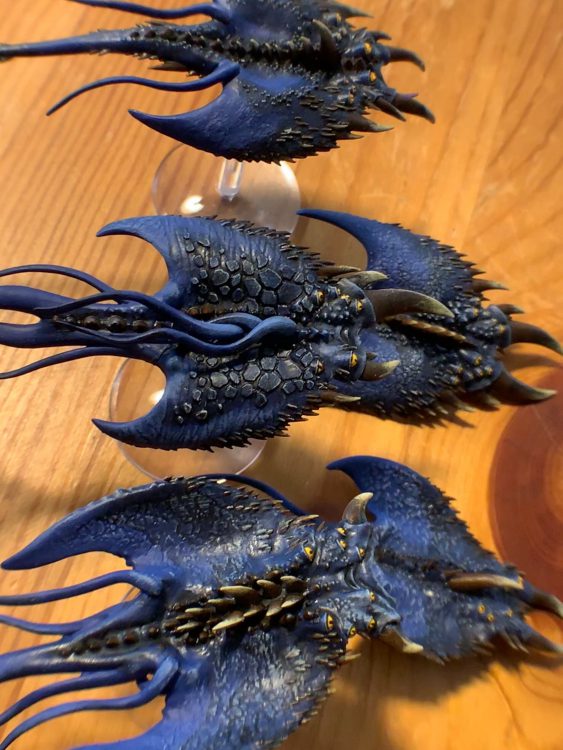
Let’s Build Some Lists
It’s time to put this into practice. Let’s build some daemons lists we can start playing with.
Slaanesh and Nurgle
Chaos Daemons Battalion Detachment (-6 CP, 1,235 Points)
Allegiance: Slaanesh
HQ: Keeper of Secrets w/Living Whip, Exalted: Random, Powers: Hysterical Frenzy, Delightful Agonies
HQ: Keeper of Secrets w/Living Whip, Exalted: Random, Powers: Cacophonic Choir, Pavane of Slaanesh
HQ: Keeper of Secrets w/Living Whip, Exalted: Random, Powers: Phantasmagoria, Symphony of Pain
Troops: Daemonettes x20 w/Alluress, Icon, Instrument
Troops: Daemontettes x10 w/Alluress
Troops: Daemontettes x10 w/Alluress
EL: Fiends x3
EL: Fiends x3
Chaos Daemons Patrol Detachment (-1 CP, 765 Points)
HQ: Lord of Change, Exalted: Random, Relic: The Impossible Robe, Powers: Infernal Gateway, Gaze of Fate, Treason of Tzeentch, Warlord: Born of Sorcery
HQ: The Contorted Epitome
Troops: Nurglings x5
Troops: Nurglings x5
EL: Beasts of Nurgle x3
This list starts with only 5 CP but gets its money’s worth out of the Exalted upgrades on the Greater Daemons. It still has the issues with Abhor the Witch being taken against it, though that will often be your challenge working with Chaos Daemons. This list uses Nurglings to occupy objectives early and often, quickly followed up by Daemonettes pressing the middle of the table. Not far behind (or even ahead) you have the huge threat of the Keepers, with the extremely hard to kill Lord of Change throwing out psychic firepower from behind. Some opponent swill be able to chew through the wall of giant Daemons, but especially on the smaller boards, many will be overwhelmed.

Nurgle Soup
Overall Daemons will still struggle with some threats and I don’t expect monofaction Daemons to be the preferred way of running them in competitive play. This list, which Alex Petford piloted to a 5-1 2nd place finish at the Vanguard Tactics Grand Series this past weekend, is more emblematic of how I expect to see Daemons run in these early days, using them as a way to supplement Death Guard, Thousand Sons, or Chaos Space Marines using Nurglings to occupy objectives.
Nurgle Patrol Detachment (0 CP, 520 Points)
HQ: Death Guard Daemon Prince of Nurgle [9 PL, 195pts]: 1. Miasma of Pestilence, Hellforged sword, Wings
Troops: Nurglings x4 [6 PL, 80pts]
Troops: Nurglings x4 [6 PL, 80pts]
Troops: Nurglings x4 [6 PL, 80pts]
EL: Foul Blightspawn [4 PL, 85pts] w/Fugaris Helm, Warlord: Arch-Contaminator
Death Guard Spearhead Detachment (-5 CP, 1,020 Points)
Plague Company: The Poxmongers
HQ: Sorcerer [6 PL, 90pts, -1CP]: 4. Blades of Putrefaction, 5. Putrescent Vitality, Relic: Ironclot Furnace (-1 CP)
Troops: Plague Marines [13 PL, 180pts] x10 w/Bolter, Plague Knife
EL: Biologus Putrifier [4 PL, 65pts]
FA: Chaos Spawn [6 PL, 69pts, -1CP]: Chaos Spawn, Chaos Spawn, Chaos Spawn, Contaminated Monstrosity (-1 CP)
HS: Plagueburst Crawler [8 PL, 160pts, -1CP]: 2x Entropy cannon, Heavy slugger, Accelerated Entropy (-1 CP)
HS: Plagueburst Crawler [8 PL, 160pts]: 2x Entropy cannon, Heavy slugger
HS: Plagueburst Crawler [8 PL, 160pts]: 2x Entropy cannon, Heavy slugger
DT: Terrax-Pattern Termite Assault Drill [8 PL, 136pts] w/2x Storm Bolters
Chaos Daemons Patrol Detachment (-2 CP, 460 Points)
Chaos Allegiance: Nurgle
HQ: Daemon Prince of Chaos [9 PL, 200pts]: Malefic talons, Wings, Fleshy Abundance, Nurgle
Troops: Nurglings [6 PL, 100pts] x5
Troops: Nurglings [6 PL, 100pts] x5
Troops: Nurglings [6 PL, 100pts] x5
++ Total: [119 PL, -3CP, 2,000pts] ++
Author’s Note: Unless I’m missing something I think there’s an issue with this list’s relics situation (the Ironclot Furnace can’t be taken unless the Warlord is from the Poxmongers, which can’t be the case because as listed, the Warlord is in a Poxmongers detachment.
This list makes heavy use of Nurglings to get out in front of the otherwise slow-moving Death Guard units and hold objectives early on. The Chaos Daemons Daemon Prince of Nurgle gives the army an extra psyker without opening it up to too much to Abhor the Witch, while giving it the Locus of Virulence aura that can apply to the Plagueburst Crawlers and boost their damage output while both Daemon Princes can lend their re-roll 1s auras to the tanks as they rumble forward shooting their improved Entropy Cannons. The Blightspawn can also boost the PBCs’ output with the ability to re-roll wounds and he can take out incoming threats himself or combine with the Daemon Princes to make a nightmare counter-charge duo with his 10″ fight last aura.
The Plague Marines pile into the drill with a pair of characters – typically this will probably be the Sorcerer and the Biologus Putrifier, though you could swap in the Blightspawn as needed depending on the threats and if you wanted the Plague Marines to focus more on melee. Otherwise the unit can arrive in the drill, jump out, and be ready to raise hell with the Blight Bombardment stratagem and boosted combat output from Trench Fighters, Putrescent Vitality, and Blades of Putrefaction.
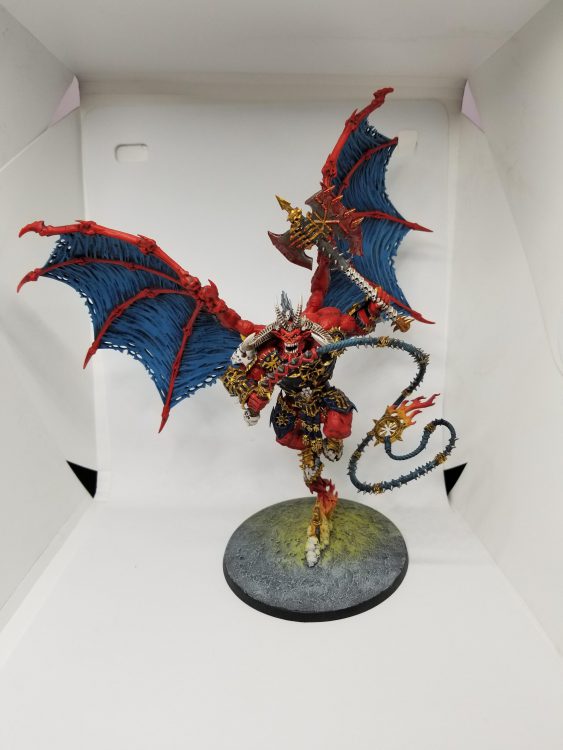
Monster Mash
We posted this in the Thousand Sons Faction Focus, but it’s worth reposting here where it’s less of a troll for readers. This list is patterned after the one that Davis Frye recently piloted to a 1st-place finish at a 9th-edition release party RTT in Virginia, and focuses on threat saturation with big daemons (Frye has given credit to Seth Riggins for coming up with the list).
Chaos Daemons Battalion Detachment (-3 CP, 1,035 points)
HQ: Keeper of Secrets w/Shining Aegis, Exalted (-1 CP), Powers: Delightful Agonies, Phantasmagoria
HQ: Lord of Change w/Baleful Sword Exalted (-1 CP), Powers: Infernal Gateway, Bolt of Change, Gaze of Fate
HQ: Bloodthirster of Insensate Rage, Exalted (-1 CP)
Troops: Nurglings x5
Troops: Nurglings x5
Troops: Nurglings x5
Super-Heavy Auxiliary Detachment (-3 CP, 495 points)
LoW: Mortarion (495), Powers: Miasma of Pestilence, Blades of Putrefaction
Thousand Sons Supreme Command Detachment (+3 CP, 465 points)
LoW: Magnus the Red (465), Warlord, Powers: Warptime, Doombolt, Weaver of Fates, Tzeentch’s Firestorm
The list packs a massive psychic wallop, able to cast from all three disciplines with some powerful casters, while having some powerful melee threats. The Nurglings are there to occupy objectives from the beginning of the game and come in units large enough to be a real pain to move, especially since they can use the Nurgling Infestation Stratagem from Engine War to regenerate after they take losses. The Bloodthirster is interesting in that it reduces the number of Abhor the Witch targets, which potentially buys it a turn or two to fly under the radar.
Also, I asked Davis about which Exalted Traits he chose, and this was his reply:
So i never really picked them. I always rolled. But i got extremely lucky on the rolls for the Bloodthirster. He had +2 charge every game.
Absolute Legend.
Outlook: Decent
There’s a lot to like about Chaos Daemons following the points changes, and they have some great Troops that can be real monsters in 9th edition’s board control game. Where they’ll struggle a bit is with killing large targets (though hopefully shifts in the meta will make knights less of an issue), and having psyker-heavy armies will mean that Abhor the Witch is an easy take and very max-able against daemons armies every game.
Have any questions or feedback? Drop us a note in the comments below or email us at contact@goonhammer.com.
